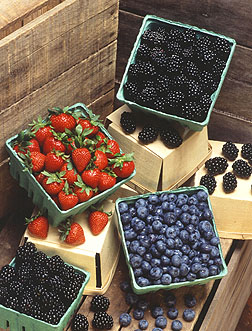 Image Number K7229-19 |
A bowl of berries is a treat for the eye as well as a delight for the palate. But these tasty little morsels happen to be quite tricky to grow, harvest, and handle. These crops tend to have brief growing seasons and are vulnerable to insects, disease, and even birds, so ARS scientists have given them lots of attention.
Take strawberries. In the 1950's, ARS actually saved the strawberry industry in the Great Lakes region when we released the first varieties that could survive red stele, a root-rotting fungus. We're also old hands at strawberry breeding. ARS came up with such June-bearing favorites as Earliglow, a sweet and juicy berry with a wonderful flavor. We've also bred berries that bear fruit from spring until well into the fall like Tribute and Tristar, which have brought new market opportunities to Northwest strawberry growers.
Fifteen years ago, blueberries were practically nonexistent in the Gulf States. But our early-ripening varieties have extended highbush blueberry culture to the Deep South. Today, over 10,000 acres are grown in Dixie, with more than 4,000 acres thriving throughout Texas, Louisiana, and Alabama.
In the Pacific Northwest, where most of our red raspberries are grown, Willamette, a 1943 release, still accounts for 40 percent of the red raspberry acreage.
And, when USDA blackberry breeders introduced the first truly genetic thornless blackberries, Thornfree and Smoothstem, they caused a small roadside revolution. The new varieties were just what some growers needed to establish pick-your-own operations.
Photo by Scott Bauer.

